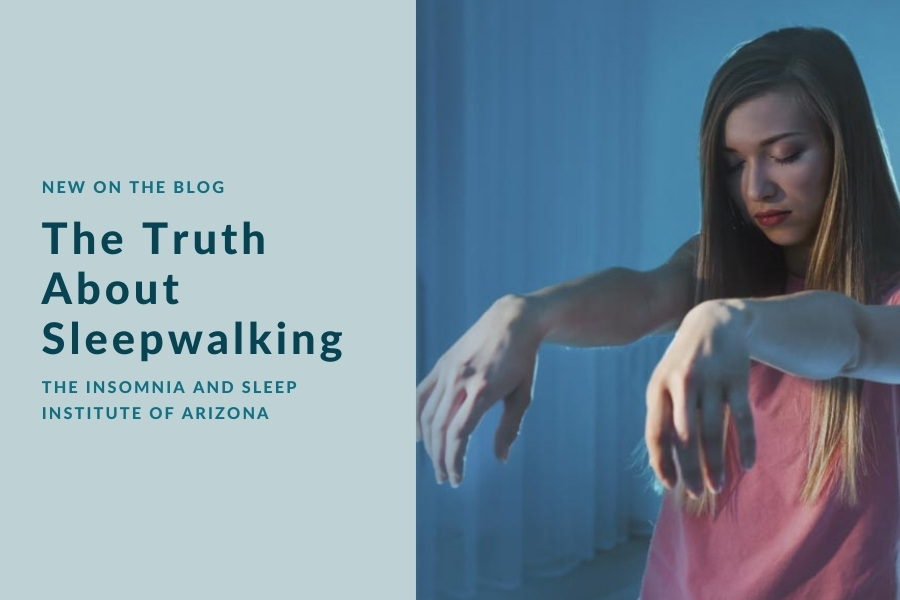Sleepwalking is an event that is so common in entertainment that it has become a trope buried in misinformation and myths. The Insomnia and Sleep Institute of Arizona diagnoses and treats all sleep disorders including somnambulism, the type of parasomnia event colloquially called “sleepwalking.” We are staffed exclusively by sleep specialists and offer unparalleled staffing levels in an outcome-driven environment. We know that the best treatment must begin with the right diagnosis, and that’s why your initial consultation (and every visit moving forward) is only with a sleep expert.
Sleepwalking features fairly obvious symptoms. The most well-known is getting up and walking around while still asleep, but many patients exhibit other complex actions during these events as well. For instance, a patient might sit up in bed and look around (eyes open much of the time), often looking confused. A patient might get up quickly and run away. They may act like they are in a nightmare and trying to escape. The “walking” aspect of sleepwalking is not necessarily always exhibited, or it might be coupled with numerous other activities.
Sleepwalking Realities
Some people who sleepwalk might also talk or yell. Many patients with this condition have their eyes open during these events, and their look is typically described as looking “glassy.” If you live with someone who sleepwalks, the person might seem to be looking through you rather than at you. Sleepwalkers might start doing daily activities during these events, and it’s not uncommon for these actions to be crude. For example, toilet activities might be done in a trash can or they might try to climb out of a window. In some cases, a sleepwalker’s behavior is violent, putting themselves and/or others at risk.
Although it is somewhat rare, sleepwalkers have also been known to get into cars and try to drive. Happenings such as indecent behaviors or unwanted sexual behaviors might occur. Some patients eat when sleepwalking. If you live with a sleepwalker, you know it can be very tough to wake them up and when you do succeed, they are often confused. They might recall snapshots of what happened, but oftentimes don’t remember anything they did while sleepwalking.
The Dangers of Sleepwalking
The dangers of sleepwalking on the superficial level are clear. There are instances when the sleepwalker might be violent when awakened. However, it is important not to overlook the subtler risks of sleepwalking. Sleepwalking typically occurs in the first third of a night’s sleep, during the slow-wave cycle. This means the sleepwalker is not getting the quality and amount of sleep they need (or think they are getting). Similar to insomnia, sleep apnea, and other sleep disorders, this means there are lingering effects that are connected to sleep walking.
Daytime fatigue, behavior problems in children, learning struggles, and a lower quality of life may all be side effects of a sleep disorder like sleepwalking. Poor quality sleep has also been linked to a number of co-morbidities such as strokes and heart disease. If you or someone in your home is a sleepwalker, help is available.
Treatment for Sleepwalking
Diagnosis is the first step, and treatment(s) for any parasomnia event will be customized to the patient. It’s a mistake to think that sleepwalking is a “normal” part of a child’s life and that they will outgrow it. They may, but that does not mitigate the dangers they put themselves and others into. Hoping they grow out of it does not help them get the sleep they need for healthy growth.
Adults who sleepwalk are also a risk to themselves and others. Cognitive behavioral therapy for insomnia (CBT-I), a change in sleep hygiene practices, and addressing any potential underlying issues are all key approaches that may be taken to help with sleepwalking. No two treatment plans are identical because addressing sleepwalking or any sleep disorder should be individualized to each patient.
At The Insomnia and Sleep Institute, we treat patients as young as two for parasomnia events and all other sleep disorders. Our team of experts is committed to helping you get the diagnosis and treatment that you need. Call us today at (480) 745-3547 to schedule your consultation or connect with us by completing the online form.





